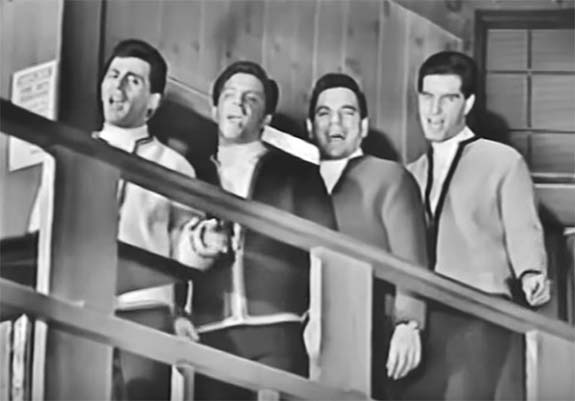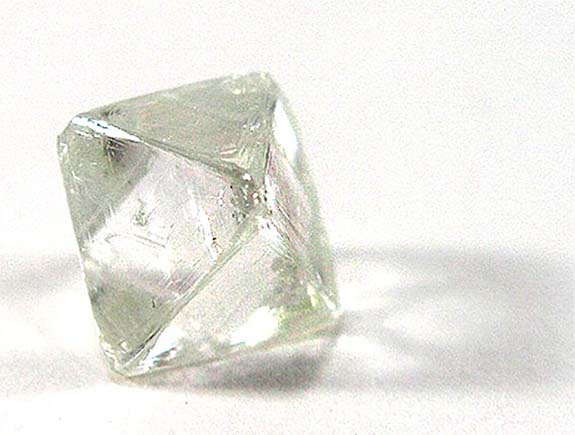Welcome to Music Friday when we often bring you throwback songs with jewelry, gemstones or precious metals in the title or lyrics. Today, Frankie Valli makes a last-ditch attempt to save a failing relationship in his 1965 hit, "Let's Hang On!".
As the song begins, we learn that Valli's significant other is looking to "call it quits," but the falsetto-crooning frontman of The Four Seasons makes his case by pointing to the diamond ring on her finger.
He sings, "That little chip of diamond on your hand / Ain't a fortune, baby, but you know it stands (for the love) / A love to tie and bind us (such a love) / We just can't leave behind us / Baby (don't you go) / Baby (oh no no) / Baby, stay-ay."
Composed by Bob Crewe, Sandy Linzer and Denny Randell, "Let's Hang On!" was one of The Four Seasons' most memorable tunes, ascending to #3 on the U.S. Billboard Hot 100 singles chart. Sixteen years later, Barry Manilow released his rendition of the song, but it only got to #32 on the Hot 100 chart.
According to music historians, the popularity of "Let's Hang On!" stems from several unique devices in the arrangement.
The first is Valli's three-line introduction: "There ain't no good in our goodbye-in' / True love takes a lot of tryin' / Oh I'm cryin'."
The next is the use of two fuzz guitars (with one musician playing high notes and the other playing low notes).
Still another is Valli's extreme falsetto, and the last is the use of backing vocals that provide counterpoint to Valli's main phrasing.
Founded in 1960, The Four Seasons included four Newark, N.J., natives: Bob Gaudio, Frankie Valli, Tommy DeVito, and Nick Massi. The origins of the group are chronicled in the long-running Broadway musical, Jersey Boys.
The Four Seasons were inducted into the Rock and Roll Hall of Fame in 1990 and are credited with selling more than 100 million records. The 85-year-old frontman is still touring, with upcoming stops in Thousand Oaks, CA; Windsor, Ontario; Orillia, Ontario; Las Vegas, NV; Philadelphia, PA; New York, NY; Kingston, NY; and Port Chester, NY.
Trivia: Frankie Valli's real name is Frank Castelluccio. The inspiration for his stage name came from the female country singer Texas Jean Valley.
Please check out the audio track of Frankie Valli and The Four Seasons singing "Let's Hang On!". The lyrics are below if you'd like to sing along...
"Let's Hang On!"
Written by Bob Crewe, Sandy Linzer and Denny Randell. Performed by Frankie Valli and The Four Seasons.
There ain't no good in our goodbye-in'
True love takes a lot of tryin'
Oh I'm cryin'
Let's hang on to what we've got
Don't let go, girl, we've got a lot
Got a lot of love between us
Hang on, hang on, hang on to what we got
Dooh doo, dooh doo, dooh doo
You say you're gonna go and call it quits
Gonna chuck it all and break our love to bits (breaking' up)
I wish you'd never said it (breakin' up)
Oh no, we'll both regret it
That little chip of diamond on your hand
Ain't a fortune, baby, but you know it stands (for the love)
A love to tie and bind us (such a love)
We just can't leave behind us
Baby (don't you go)
Baby (oh no no)
Baby, stay-ay
Let's hang on to what we've got
Don't let go, girl, we've got a lot
Got a lot of love between us
Hang on, hang on, hang on, to what we've got
Dooh doo, dooh doo, dooh doo
There isn't anything I wouldn't do
I'd pay any price to get in good with you (patch it up)
Give me a second turnin' (patch it up)
Don't cool off while I'm burnin'
You've got me cryin' dyin' at your door
Don't shut me out, ooh let me in once more (open up)
Your arms I need to hold you (open up)
Your heart, oh girl I told you
Baby (don't you go)
Baby (oh no no)
Baby, stay
Let's hang on to what we've got, girl
Don't let go, girl, we've got a lot
Got a lot of love between us
Hang on, hang on, hang on, to what we've got
Dooh doo, dooh doo, dooh doo
Credits: Screen capture via Youtube.com.


